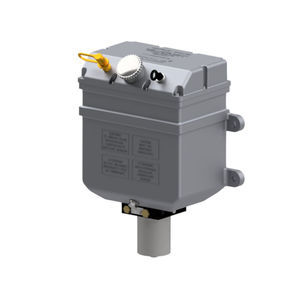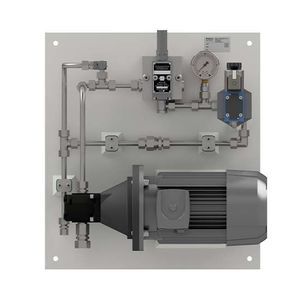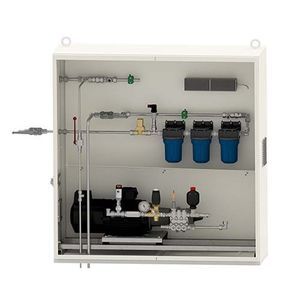
- Products
- Catalogs
- News & Trends
- Exhibitions
Oil lubrication system

Add to favorites
Compare this product
Characteristics
- Lubricant
- oil
Description
The BEKA Dry belt system offers the advantage of an effective belt lubrication without the use of water and soap and are suitable for the use of common dry belt media like oil with
Teflon or silicones.
Besides the common use as a belt lubrication system for the filling- and packing industry (typically used for surface treatment), the system can also be used as a pure return belt
system.
Dry belt system
Oil containing Teflon or silicones is applied precisely onto the conveyor belt. As a result, the objects on the belt slides smoothly. No water and soap contaminate your products and
environment. Wear and tear between objects and belt are reduced. This solution is often used for an internal transport of products to reduce the friction of heavily loaded belts on
conveyor belts.
Pure return belt system
Oil containing Teflon or silicones is injected between the belt and support plate. This solution is often used for an internal transport of products into reduce the friction of heavily loaded belts on tracks. As a result, the belt runs smoothly, noise and current consumption of the driving motors are reduced.
Groeneveld-BEKA offers 2 dry belt systems, the Foodline Mini and the Foodline Max. The Mini is perfect for smaller machines and systems. The Max is the ultimate solution for mid-sized machines and big plants.
System overview
The system housing contains the control panel, the main switch and the pressure gauge. All parts which come in contact with the medium are made of stainless steel or Viton. Both Foodline Mini and Max are suitable for all kind of lubricants, with a thin or high viscosity.
Catalogs
No catalogs are available for this product.
See all of GROENEVELD-BEKA‘s catalogsRelated Searches
- GROENEVELD-BEKA pump
- GROENEVELD-BEKA industrial pump
- Pump with electric motor
- GROENEVELD-BEKA stationary pump
- Lubricant pump
- Lubricating oil pump
- Compact pump
- Suction pump
- Air-driven pump
- Flow pump
- Top-mounted pump
- Metering pump
- Vertical pump
- Process pump
- High-pressure pump
- Air pump
- Mineral lubricant
- Anti-corrosion lubricant
- Gear pump
- 24 V pump
*Prices are pre-tax. They exclude delivery charges and customs duties and do not include additional charges for installation or activation options. Prices are indicative only and may vary by country, with changes to the cost of raw materials and exchange rates.





